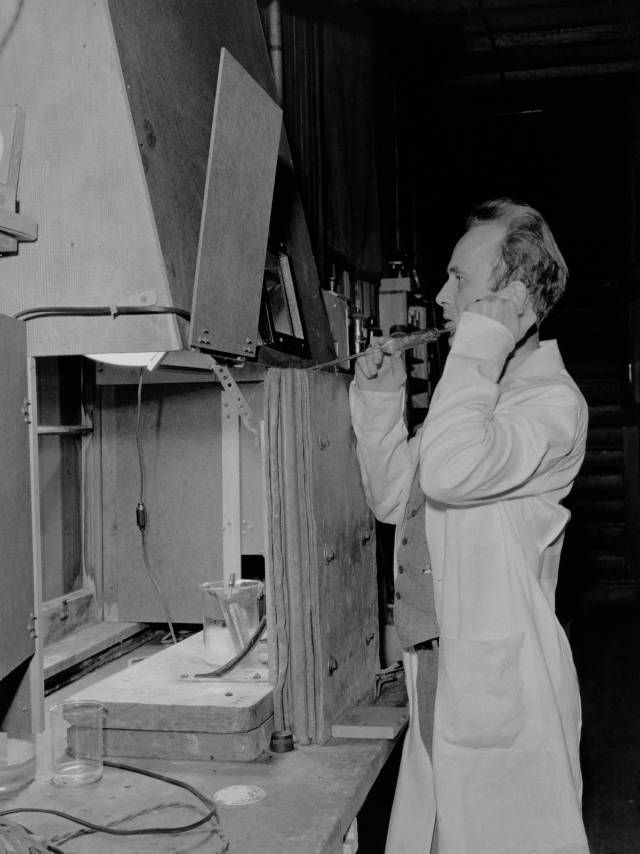Joseph Gilbert “Joe” Hamilton (1907-1957) was a physician who directed biomedical research at the Berkeley site of the Manhattan Project. He later became director of the Crocker Radiation Laboratory at the University of California, Berkeley.
The son of a pioneer in the field of psychology, Hamilton was born in Waverley, MA, but grew up in Santa Barbara, CA. He received his undergraduate degree from Berkeley in 1929 and his medical degree from the University of California, San Francisco in 1936. He went on to hold professorships at both schools, and was one of a large cadre of Manhattan Project medical scientists with connections to the two California campuses.
MANHATTAN PROJECT INVOLVEMENT
Hamilton became interested in radiation when the Berkeley cyclotron, developed by Ernest Lawrence, started producing radioisotopes for research. He worked with the Radiation Laboratory (Rad Lab) throughout the 1930s, researching metabolism and clinical uses of radioactive materials. He worked with Robert Stone on the first cancer therapy test involving artificial radioisotopes, and was the first person to use radioiodine to diagnose thyroid disorders. In addition to Stone, Hamilton was friends with Glenn Seaborg, with whom he corresponded throughout the war.
Hamilton was hired by his old collaborator Robert Stone to work on the Manhattan Project as part of Chicago’s Metallurgical Laboratory (Met Lab). He remained at Berkeley for most of the war, however, using its cyclotrons for research. Lawrence placed him in charge of the 60-inch cyclotron in 1942. He did spend time during the project’s duration in St. Louis and Chicago, even becoming a part of the Met Lab Project Council late in the war. Some of his research covered the possibility of radiation warfare (using radioactive particles as a chemical weapon) and cyclotron experiments with heavy elements like lead, thallium, and bismuth.
Hamilton’s main focus during the Manhattan Project was on radiation safety. Once a sufficient amount of plutonium had been produced, he received 11 milligrams of it for tracer studies in rats. These experiments gave some of the earliest estimates of the toxicity of the element initially known as “94.” Hamilton discovered that contaminating the blood stream with plutonium was the most dangerous, comparing it to a “snake bite,” where the venom is supposed to be removed from the blood as quickly as possible. He also discovered the dangers of plutonium inhalation and how it accumulated in bone. He did some work on detection methods and safety standards, but stated safety and tolerance standards for radiation exposure were about “calculated risk,” not full safety.
CONTROVERSY AND POST-WAR LIFE
Hamilton had a large role in the controversial human plutonium injection experiments that began during the war, overseeing the injections that went on at Berkeley. In these experiments, a handful of patients who had been diagnosed with cancer had plutonium injected into their blood vessels or muscles, usually in addition to a surgery or other treatment. According to later accounts, Hamilton justified not informing the patients of the full nature of the injections because of the secrecy around the newly-discovered element. Later on, however, he recommended to Atomic Energy Commission (AEC) Director Shields Warren that the Commission use animals and not humans for experiments on radiation’s effects on cognition. His memo famously warned that the proposed human experiments had “a little of the Buchenwald touch,” referring to horrific Nazi medical experiments that had recently come to light.
After the war, Hamilton helped with the Operation Crossroads tests, recruited by his Manhattan Project colleague Stafford Warren. Just as he would with the AEC, he was attuned to the possibility of public backlash. Fearing overreaction to the efforts to dispose of ships used in Crossroads, he recommended against telling the public about the ships’ radiation exposure. From 1946 onwards, he served as a consultant to the AEC. In 1948, he became director of the Crocker Radiation Laboratory, a 1939 extension of the Rad Lab, which had enjoyed AEC support since the war’s end. He helped with the cyclotron work that went into the discovery of the elements that would eventually be named curium and americium.
Hamilton diagnosed himself with leukemia in 1955, which may have been connected to his cavalier approach to radiation exposure in his early days at the Rad Lab. He died in 1957 in Berkeley. Upon his death, Lawrence and Warren Garrison, a fellow Crocker Lab and Manhattan Project radiologist, wrote a tribute to him.





